Hayasaki Naiko Biotope, Kohoku Waterfowl Park, Minamihama 早崎内湖ビオトープ・湖北町水鳥公園・びわ町
|
|
|

Sign explaining about Hayasaki (Hayazaki) Naiko Biotope. It was an attached lake to Lake Biwa until it was filled in as reclaimed land in 1970.
|
|

A number of attached lakes in Shiga were reclaimed to make rice paddies amid a shortage of food after the war. This has proven to be detrimental to Lake Biwa's ecology, and now Shiga wants to restore Hayasaki's reclaimed land back to an attached
|
|

In Nov. 2001, part of the land was flooded with water as an experiment, and the ensuing plant and wildlife were observed. MAP
|
|

This area seen here has been flooded with water as part of the biotope. Reed beds now flourish. Mt. Ibuki is in the background. These pictures were taken in Feb.
|
|

Mt. Ibuki
|
|

Where there are reeds, there is life.
|
|

In winter, migratory birds come to Hayasaki Naiko Biotope.
|
|

Reeds oin a flooded part of the Hayasaki Naiko Biotope.
|
|

This is where kids can play in the water and catch fish, etc. After observing and identifying the fish, prawns, etc., the kids return the fish back into the water. Fishing is prohibited here.
|
|

For demonstrative purposes, an arrow-shaped "eri" fish trap was recently built in the biotope. It is similar to the ones found in Lake Biwa. It leads fish swimming along the fence into a small area where they can be caught.
|
|
|

At the end of the arrow tip is where the fish eventually gather so fisherman can just scoop up the fish. The fish don't backtrack and so they don't escape this place.
|
|

Looks like a prime place for fish and birds to dwell.
|
|

Reeds and Mt. Ibuki
|
|
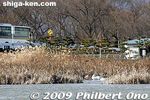
Migratory birds in Feb.
|
|

Ducks seek the protection of the reeds.
|
|
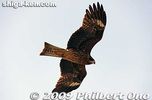
Meanwhile above, a black kite soars above looking for fish. The bird is a common site at Lake Biwa.
|
|

In summer. Looking at the Hayasaki Naiko reclaimed land from the southern edge with Yamamoto-yama in the distance. This part is not yet flooded and still remains as rice paddies..
|
|

Hayasaki Naiko biotope is still largely rice paddies. For decades since 1970, rice farmers had to toil extra hard due to the water level being lower than Lake Biwa's. The paddy soil is extra watery and soft. Water has to be pumped out constantly.
|
|

Water intake pumping station. The water drainage pumping station is in another location.
|
|

This part was flooded in 2001, and it is now teeming with reeds, fish, and other wildlife which entered this wetland naturally over the years. A local NPO conducts tours and hands-on activities for kids and adults.
|
|

Reed beds abound in the southern portion of the biotope. Invasive species are also very minimal compared with Lake Biwa.
|
|

Reeds are vital for fish and birds. They can spawn or nest here and hide from predators. Reeds also function as a water purifier. Lake Biwa has lost much of its reed beds due to development.
|
|

Chonoki River cuts through the biotope. Looking upstream. 丁野木川
|
|

Chonoki River looking downstream toward Lake Biwa. This river divides the Hayasaki biotope into the northern and southern areas.
|
|

On the northern area, is this flooded area. Less reeds than in the southern area. This area is more suited for migratory birds like swans which come here each winter. This place is popular with bird watchers and wildlife photographers in winter.
|
|

Northern area of Hayasaki biotope. Hayasaki naiko has an area of 17 hectares. About one-fourth of this has been flooded on an experimental basis. The flooded paddies are leased to Shiga Prefecture which pays rent to the land owners.
|
|

On the right of the flooded section are rice paddies not yet flooded. Shiga wants to eventually purchase all the reclaimed land and flood the entire area to restore Hayasaki Naiko.
|
|

This is the eastern edge of Hayasaki Naiko. The original lake's edge was up to here. This stone wall is original, existing when Hayasaki Naiko was still an attached lake.
|
|

Houses in Hayasaki village faced the eastern shore of Hayasaki Naiko. When the restoration is completed, this road would have to be further elevated by 1 meter or so as an embankment.
|
|

What used to be a lake is a rice paddy. Imagine this to be a lake, with an embankment in front of these homes.
|
|

View of Hayasaki Naiko from the eastern edge. One stumbling block to the restoration is high land prices. Shiga needs to purchase all of the reclaimed land.
|
|

View of Hayasaki Naiko from the eastern edge. There is a committee for restoring Hayasaki Naiko, but reaching an agreement on planning and implementation takes a long time.
|
|

Rice paddy and reed bed. Special thanks to Makino Atsushi (Lake Biwa Museum) and Kurahashi Yoshihiro (Hayasaki Biotope Networking) for the tour of Hayasaki biotope.
|
|

Rice paddy and reed bed. Restoring Hayasaki Naiko may take decades. For tours (May-Nov.) of Hayasaki biotope, call in Japanese: 0749-72-2262 (Hayasaki Biotope Networking).
|
|

Sign welcoming you to the Kohoku Town Waterfowl Park along the northeastern shore of Lake Biwa, directly north of Nagahama. MAPThis is slightly north of Hayasaki Biotope.
|
|

Map of Kohoku-cho Waterfowl Park that includes a bird-watching center called Kohoku Wild Bird Center and the Biwako Waterfowl and Wetland Center.
|
|

Kohoku Wild Bird Center and the Biwako Waterfowl and Wetland Center (A-frame building on the left). 湖北野鳥センター・琵琶湖水鳥・湿地センター
|
|

Kohoku Wild Bird Center, admission 200 yen. This center was established by Shiga Prefecture in Nov. 1988 and it is operated by Kohoku town. 湖北野鳥センター
|
|

Inside Kohoku Wild Bird Center. It has large picture windows facing Lake Biwa and high-powered binoculars enabling you to clearly see the waterfowl. 湖北野鳥センター
|
|

View from the Kohoku Wild Bird Center.
|
|

The birds rest on a small island close to the shore.
|
|

On this day in Feb., I saw ducks and gray heron (ao-sagi).
|
|

Ducks
|
|

Tundra swans from Siberia at Lake Biwa.
|
|
|

Bean geese at Lake Biwa.
|
|
|
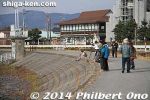
Amateur photographers, birdwatchers, and sightseers along the shore during winter is a common sight.
|
|

The Kohoku Wild Bird Center is well equipped for bird-watching and also features exhibits of stuffed birds.
|
|

Bulletin board indicating the bird species observed that day and where they were seen in the area. The center keeps track of bird locations in Lake Biwa, Hayasaki Naiko Biotope, and Mt. Yamamoto-yama.
|
|

Display of various bird nests.
|
|

On the opposite side of the center is Mt. Yamamoto-yama. On this day in Feb., we saw the Steller's sea eagle perched on a tree on this mountain.
|
|

Actual-size cutout of Steller's sea eagle. The center has two telescopes aimed at the bird for a clear view. It is a very large bird with a wingspan of over 2 meters. You need a very large telephoto lens to photograph the bird on the mountain.オオワシ
|
|

Explanation of Steller's sea eagle and its movement in the area.
|
|

Migratory patterns in the Kohoku area.
|
|

Connected via a passageway to the Kohoku Wildbird Center is the Biwako Waterfowl and Wetland Center set up by the Ministry of the Environment in 1997. It is also operated by Kohoku town.
|
|

Viewing room in the Biwako Waterfowl and Wetland Center.
|
|

Autographs of various prominent people who visited the Kohoku Wild Bird Center.
|
|
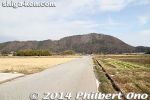
Mt. Yamamoto-yama
|
|

Kohoku Mizudori Station, a local roadside shop/restaurant for tourists traveling by car.
|
|
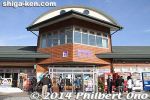
Kohoku Mizudori Station, a local roadside shop/restaurant for tourists traveling by car.
|
|
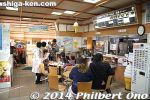
Inside Kohoku Mizudori Station, with a food stand and restaurant.
|
|
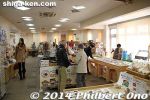
Inside Kohoku Mizudori Station, selling local products and souvenirs.
|
|
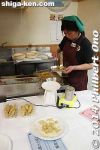
This booth had ko-ayu sweetfish tempura.
|
|
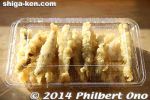
Ko-ayu sweetfish tempura, fresh out of the oil. Yummy!
|
|
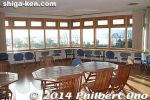
The 2nd floor of the Kohoku Mizudori Station for resting and dining. Also views of the lake and birds.
|
|
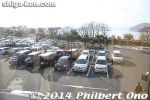
From the 2nd floor of the Kohoku Mizudori Station.
|
|
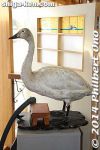
Stuffed tundra swan.
|
|
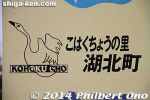
This area is called Kohoku-cho which used to be a separate town before merging with Nagahama.
|
|
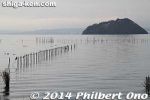
A defunct eri fish trap.
|
|

Some nice lakeside scenery while cycling further north from Kohoku Waterfowl Park.
|
|

Nice cycling path along the shore.
|
|
|
|
|
|
|

Yamamoto-yama mountain
|
|

Slightly south of Hayasaki Naiko Biotope along the shore is Oku Biwa Sports no Mori. This is a nice outdoor sports complex. Outdoor pool is great for kids in summer.
|
|

Lotus pond at Oku Biwa Sports no Mori. In summer, the lotus bloom.
|
|
|
|
|

Lakeside park in northern Nagahama (Biwa-cho), slightly south of Oku Biwa Sports no Mori. Nice cycling path along the lakeshore.
|
|

View of Chikubushima island
|
|

Lakeside park in northern Nagahama. This area was formerly Biwa-cho town which merged with adjacent Nagahama in Feb. 2006.
|
|
|

Lakeside park with a nice, long cycling path.
|
|
|

River mouth
|
|

Minamihama swimming beach, Nagahama 南浜
|
|

Minamihama swimming beach in Nagahama. Pebble beach. 南浜
|
|

Minamihama swimming beach. Don't swim beyond the buoys. 南浜
|
|

南浜
|
|

南浜
|
|

南浜
|
|

Nagahama in the distance from Minamihama
|
|

Minamihama beach
|
|
|
|
|
|
|
|

Sumo ring on the beach
|
|
|
|
|